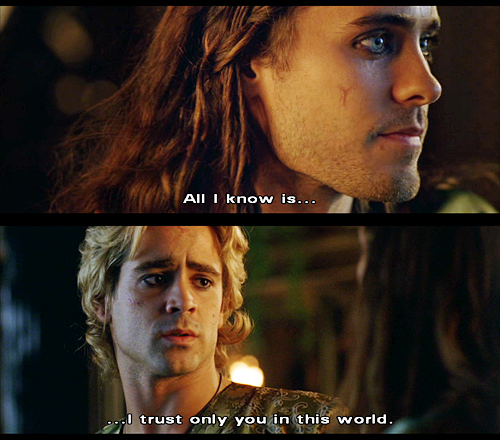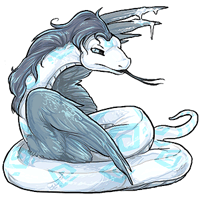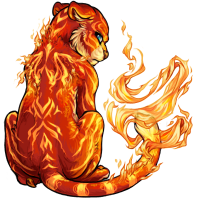Information
Hephaistion has a minion!

Briseis the Hell-Fire

Briseis the Hell-Fire
Hephaistion
Legacy Name: Hephaistion
The
Owner:
Age: 15 years, 5 months, 4 weeks
Born: November 5th, 2008
Adopted: 15 years, 5 months, 4 weeks ago (Legacy)
Adopted: November 5th, 2008 (Legacy)
Statistics
- Level: 112
- Strength: 112
- Defense: 112
- Speed: 112
- Health: 119
- HP: 114/119
- Intelligence: 420
- Books Read: 417
- Food Eaten: 0
- Job: Unemployed

Hephaestion (Greek: Ἡφαιστίων, alternative spelling: "Hephaistion";
(c. 356 BC - 324 BC)
Alexander The Great's general, body guard, lifelong friend, and lover.
Once in the dark he had murmured in
Macedonian, 'You are the first and the last',
and his voice might have been charged
with ecstasy or intolerable grief.'
'Fire From Heaven'
Alexander & Hephaistion
Hephaistion was Alexander's closest companion from boyhood. He became one of the king's greatest generals and stayed by Alexander's side until death. Bisexuality was common amongst Greek men and it was custom to take more than one lover. Hephaistion was special in that he was Alexander's beloved, his companion for life. Alexander and Hephaistion equated themselves to Achilles and Patroclus (respectively) and shared a bond deeper than words could describe. The two made sacrifices to the heroes and considered themselves to share the same deep love. Alexander is even known to have considered Hephaistion his alter ego. Upon meeting Alexander and his men, the Queen of Persia mistook Hephaistion to be Alexander as he was the taller and more handsome of the two. She bowed first to him, and upon realizing her mistake, must have been quite horrified. It is said that Alexander only smiled at her and said 'Do not worry, mother. He too, is Alexander.'

hxcfairy.tumblr.com
Macedonian Battle Tactics
Macedonia's rise to power was brought underway by Alexander's father and predecessor, Philip II. Philip was the greatest military inventor and army-trainer of the ancient Greek world. He designed and created a new army that elevated Macedonia to great new heights of power and eventually proved to be the strongest military force in the world. Alexander kept these changes to the army made by his father, and implemented some of his own, as well.
What follows here is a brief summary of the Macedonian army and its most commonly used tactics under Philip and Alexander.
Balance and variety were the traits that gave the Macedonian army its great strength. The whole of the army integrated many of the best warriors and their specific skills from the surrounding areas that had been absorbed through conquest. The element of the long-range missile was introduced by Thracian javelin throwers, Greek slingers, and Cretan archers. With these new additions, the most fundamental units of the army were still kept in order and continued to be finely tuned.
Undoubtedly, the most well-known Macedonian unit was the phalanx created by Philip. The phalanx was formed by infantrymen armed with 16-foot long spears called sarrissai. The phalanx was composed of 256 (16 x 16) men and could move as a cohesive unit directed by a trumpeter. The phalanx was very versatile and could move forwards, backwards, side to side, and diagonally. Each man was armed with leg armor, Phrygian-type metal helmets, and a small convex shield slung about the neck to leave both arms free to maneuver the long spears. The phalanx could act defensively to repel enemy foot soldiers and cavalry. It could also part to create channels by which enemy chariots could pass through without harm to the men. The phalanx was primarily utilized by Alexander as a force to drive the enemy into the optimum place by which it would then be struck by the cavalry.
Macedonia had always boasted a strong cavalry, but Philip reformed it to his liking and thus improved on it even more. To the left of the phalanx, Philip positioned his cavalry in pointed formations; wedge-shaped ones for the Companion Cavalry, and diamond-shaped ones for the Thessalian Greek allies. These pointed formations increased maneuverability as each rider would focus on the one directly in front of him and turn as he did, much like a flock of birds. The riders sat on padded saddlecloths that in Macedonian tradition were often the skins of animals. They carried no shields and wore only metal breastplates and leather "skirts" that went to mid thigh. They wore helmets of the Boeotian Greek style and carried a kopis, a kind of slashing sword for close-combat fighting, as well as a 9-foot long spear called a xyston to give them a longer reach. Once these spears had been deployed into the enemy, the soldier would rely upon his kopis.
The cavalry charges were done at an angle to strike into the center of an enemy line. These angled charges carried out by his wedge-shaped Companion Cavalry proved to be Alexander's main striking arm and their blow often finished off the battle. This tactic was employed by Alexander in all of his major battles and it proved successful time and time again.
Alexander would organize his units to best combat those of his enemy and would always take the enemy's strategy into account to better modify his own.
Alexander's army was composed of additional units not discussed here such as the Royal Shield Bearers, and the Royal Foot Companions, men who would run alongside the cavalry on foot. Alexander also mastered the art of siege warfare, his greatest triumph of the sort being the Siege of Tyre where he built a mole out to connect the island citadel to the mainland in order to deploy his monstrous siege machines that he had had built to counter the towering 150-foot high walls of Tyre.
Alexander's army also used animals other than horses in battle. Trained dogs and elephants were put to use in battle; the dogs mainly trained for pursuit of the retreating enemy.
Mares were imported by the thousands to breed with the best stallions in order to produce the finest warhorses.
Alexander's army was one that utilized everything in its possession and worked like a well-oiled machine. No enemy force he ever encountered had the organizational nor tactical genius that was applied to Alexander's great army. It is because of this that Alexander became the supreme conqueror of the ancient world and the acknowledged military genius that he is known as today.
ALL TEXT (c) ME, ELIZABETH BAKER ((
DO NOT TAKE.
Profile isn't complete!
Still under construction. Keep checking back.
coming soon:
- Life story
- fictional piece
Pet Treasure

Ivory Dip Pen

Mark of Luna

Gold Crescent Moon Relic

Lunar Staff

Gold Laurel

Silver Laurel

Gold Helmet

Golden Rays Top (Right Side)

Solar Kilt

Unadorned Bronze Sword

Light Blade

Irion Battle Shield

Bed Roll

Consecrated Olive Oil

Ornately Decorated Vial of Kohl

Mobile Winter Warmth Canister

Single Fig Leaf

Ornate Invitation

Swan Feather Quill Pen

Turkey Feather Quill Pen

Vernons Torn Journal Page 3

Vernons Torn Journal Page 1

Ballroom Property Manager Note

